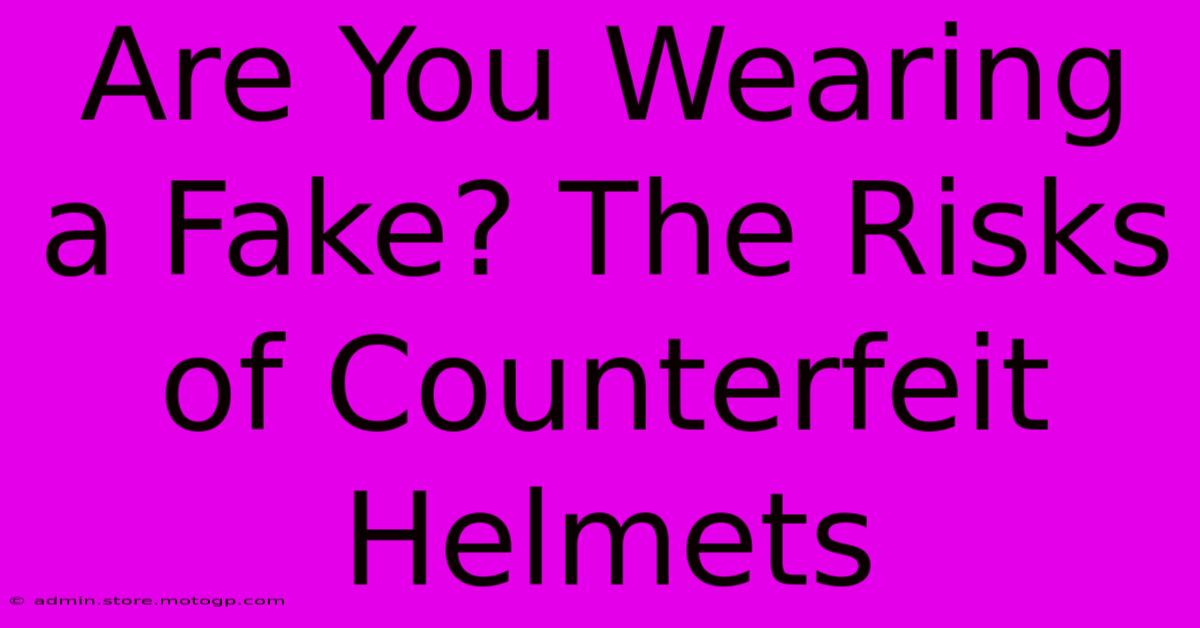Are You Wearing A Fake? The Risks Of Counterfeit Helmets

Table of Contents
Are You Wearing a Fake? The Risks of Counterfeit Helmets
Buying a helmet is a serious decision. It's an investment in your safety, a crucial piece of equipment that could save your life in a crash. But what if that investment is a counterfeit? The risks associated with wearing a fake helmet are far greater than you might think. This article explores the dangers of counterfeit helmets and how to protect yourself from becoming a victim.
The Dangers of Counterfeit Motorcycle Helmets
The allure of a bargain is strong, and counterfeit helmets often appear on the market at significantly reduced prices. However, these savings come at a devastating cost. Fake helmets often fail to meet even the most basic safety standards, putting the wearer at extreme risk in the event of an accident. Here's a breakdown of the specific dangers:
Compromised Safety Features:
- Inadequate Shell Material: Counterfeit helmets often use substandard materials for the outer shell. These materials lack the impact resistance and strength necessary to protect your head in a collision. Instead of offering protection, the shell may shatter or deform easily, exacerbating injuries.
- Weak EPS Liner: The Expanded Polystyrene (EPS) liner is crucial for absorbing impact energy. In fake helmets, this liner is frequently flimsy and insufficient, offering little to no shock absorption. This means your head will bear the brunt of the impact.
- Faulty Straps and Buckles: The chin strap is designed to keep the helmet securely on your head during an accident. Counterfeit helmets often have weak or poorly designed straps and buckles that may break or come loose, leaving your head vulnerable.
- Lack of Certification: Legitimate helmets undergo rigorous testing and certification to ensure they meet specific safety standards (e.g., DOT, ECE, Snell). Counterfeit helmets typically lack these certifications, indicating a complete disregard for safety regulations.
Beyond Physical Harm: The Legal Implications
Wearing a counterfeit helmet doesn't just put your physical well-being at risk; it also exposes you to potential legal repercussions. Depending on your location, riding a motorcycle without a properly certified helmet, or with a helmet that doesn't meet safety standards, could lead to fines or other penalties. In some cases, insurance companies might refuse to cover medical expenses related to an accident if you were wearing a counterfeit helmet.
How to Spot a Fake Helmet
Identifying a counterfeit helmet can be challenging, but there are several things to look out for:
Signs of a Counterfeit:
- Unusually Low Price: If a helmet is significantly cheaper than comparable models, be wary. It's likely a counterfeit.
- Poor Quality: Look for inconsistencies in the paint, stitching, or overall finish. A genuine helmet will have a high-quality, consistent finish.
- Missing or Incorrect Certification Marks: Carefully check for the relevant safety certification marks (e.g., DOT, ECE, Snell). Counterfeit helmets may have fake or poorly reproduced markings.
- Suspicious Packaging and Documentation: The packaging and any accompanying documentation should appear professional and legitimate. Poor-quality printing or grammar errors are red flags.
- Retailer Reputation: Purchase helmets from reputable dealers, motorcycle shops, or authorized retailers. Avoid buying from unknown online vendors or marketplaces.
Protecting Yourself: Buying a Genuine Helmet
Protecting yourself from the dangers of counterfeit helmets is straightforward:
Tips for Safe Helmet Purchasing:
- Buy from Reputable Retailers: Shop at authorized dealers and established motorcycle stores.
- Verify Certifications: Ensure the helmet carries the appropriate safety certifications for your region.
- Inspect Carefully: Thoroughly examine the helmet for any signs of poor quality or inconsistencies.
- Read Reviews: Check online reviews to gauge the reputation of the retailer and the helmet itself.
- Don't Sacrifice Safety for Price: A helmet is an investment in your safety; don't compromise on quality to save a few dollars.
In conclusion, the risks associated with wearing a counterfeit helmet are severe and far outweigh any potential cost savings. Prioritize your safety and always purchase helmets from reputable sources, ensuring they meet the appropriate safety standards. Your life depends on it.

Thank you for visiting our website wich cover about Are You Wearing A Fake? The Risks Of Counterfeit Helmets. We hope the information provided has been useful to you. Feel free to contact us if you have any questions or need further assistance. See you next time and dont miss to bookmark.
Featured Posts
-
Unlocking Speed The Red Bull Grand Prix Advantage
Feb 19, 2025
-
Cota F1 General Admission Your Key To The Race
Feb 19, 2025
-
Conquer The Competition Racing Motorcycles For Sale
Feb 19, 2025
-
Get Your Fix Of Fast Cars Any Racing On Tv Today
Feb 19, 2025
-
The Moto Gp Desmosedici Built For Speed
Feb 19, 2025
